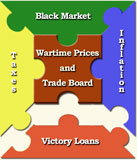

 |
|
 |
|
 Government also borrowed capital from Canadians through several different programs. The advantages of borrowing from the people were
that the government could decide the rate of interest it would pay for the money rather than having to pay what a lending institution
requested. As well, the interest it paid out would go into the pockets of Canadians rather than to banks. The first campaign to borrow
from the public was launched in 1940 in the form of a war loan drive. A second campaign was held later that year. The campaigns
consisted of the government issuing bonds. What's a bond you ask?
Government also borrowed capital from Canadians through several different programs. The advantages of borrowing from the people were
that the government could decide the rate of interest it would pay for the money rather than having to pay what a lending institution
requested. As well, the interest it paid out would go into the pockets of Canadians rather than to banks. The first campaign to borrow
from the public was launched in 1940 in the form of a war loan drive. A second campaign was held later that year. The campaigns
consisted of the government issuing bonds. What's a bond you ask?
| The war bonds were the forerunner to Canada Saving Bonds. The government now borrows from its citizens to finance the everyday business of government. How do today's interest rates compare with those paid during the war years? |
| During World War II there were ten chartered banks in Canada. Chartered banking is based on a system of a central financial system that has branches throughout the country. The United States banking system is based on unit banks, where each bank is an independent unit. |
| The name Welsher was given to anyone who cashed in his bonds early cheating the government out of the long term use of their money. Welsher is a slang term meaning to cheat or swindle. |